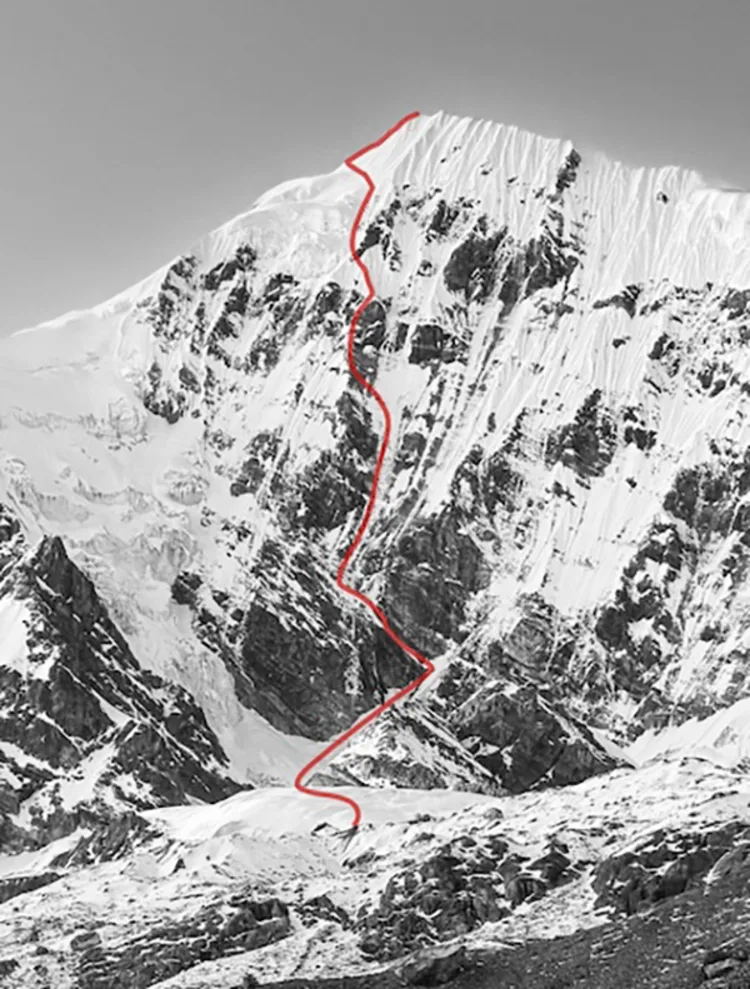Alpine-Style Breakthrough: Trio Climbs Numbur (6,958 m)
Traditional alpinism is far from fading – and a new line in the Himalayas proves it.
On October 19, 2025, Italian mountaineer Hervé Barmasse, German Felix Berg, and Polish climber Adam Bielecki completed the first alpine-style ascent of Numbur’s south face (6,958 m), a 1,000-meter wall in Nepal’s remote Rolwaling Valley.
The route, graded ED-, VI, WI5, M4, was climbed entirely without support, Sherpas, fixed ropes, or bottled oxygen. After an exposed bivouac at 6,900 m – in –25 °C cold and 60 km/h winds, without a tent or sleeping bags – the trio reached the summit and named their route “Nepali Ice SPA.”
It’s all about the mind – always the mind.” – Hervé Barmasse
In his post-climb report, Barmasse described the ascent as “wild and unpredictable.”
“When we reached the base of the wall, Adam wasn’t feeling well: he was vomiting and weak. He told us to go on without him,” Barmasse recalls.
“Felix replied, ‘We’re a team – we try together.’ Adam’s voice cut through the air: ‘Thanks, guys.’ That moment defined the climb.”
“Then, by sheer luck, a rock hit my shoulder instead of my head,” Barmasse said. “The pain was intense, but turning back would have been even more dangerous.”
Higher on the wall, progress slowed as deep snow made protection impossible. The final 200 meters became a battle through unstable snow, where “one wrong step could have sent us plummeting to the base.”
When the team reached 6,900 m, night fell. Exhausted, they decided to bivouac – with no tent, food, or sleeping bags, only an emergency tarp brought by Bielecki.
“At first, we laughed and joked,” wrote Barmasse. “Then the wind rose to 60 km/h, and the temperature dropped to -25 °C. Silence spread. We focused on a single thought: survival.”
The climbers huddled together for warmth through what Barmasse called “the hardest night of my climbing life.” At dawn, frost-free and alive, they pressed on toward the top.
“The summit welcomed us. We were happy – not just for the climb, but for the experience. The toughest climbs make the summit a detail; surviving the elements is the real achievement.”
“We reached the ridge at 7,700m and traversed some difficult terrain. From there, we hiked the classic route. Tomorrow, we’ll summit.”
Numbur is a glaciated 6,958-meter peak in Nepal’s Rolwaling Himal, about 43 kilometers southwest of Everest, straddling the border of the Janakpur and Sagarmatha regions. Its eastern neighbor is Mount Karyolung.

“Nepali Ice SPA” is born! Photo: Hervé Barmasse
The mountain’s first ascent was made in 1963 by a Japanese expedition via the southwest ridge, with Hiroshi Matsuo (Japan) and Mingma Tshering Sherpa (Nepal) reaching the summit. The last officially recorded ascent before this new route occurred in 1991, also via the southwest ridge.
The “Nepali Ice SPA” route is not only a technical success but also a statement about the spirit of modern mountaineering – minimalist, human-powered, and deeply committed to the values of teamwork and resilience. Barmasse summed it up best:
“Technically, you can be ready for anything – but for an adventure like this, you’re never ready enough. In the end, what remains is the passion for life and the awareness that surviving is the true victory.”
Their message captured both triumph and exhaustion – hallmarks of true alpine-style climbing.

